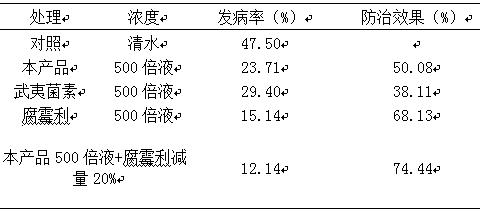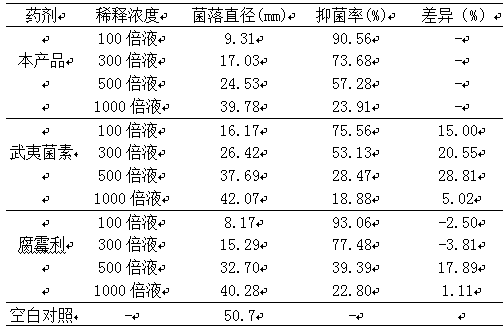Pesticide synergist with plant sources and application method thereof
A technology of botanical pesticides and synergists, applied in the directions of botanical equipment and methods, plant growth regulators, plant growth regulators, etc., can solve problems such as poor effect, large amount of pesticide use, pesticide residues, etc., and achieve improved effects , good efficacy, ensure safe effect
- Summary
- Abstract
- Description
- Claims
- Application Information
AI Technical Summary
Problems solved by technology
Method used
Image
Examples
Embodiment 1
[0040] A botanical pesticide synergist and a method of use thereof are characterized as follows:
[0041] Preparation of botanical pesticide synergist: using neem, saponins, forsythia, honeysuckle, clove, and ginkgo branches as raw materials, in terms of dry weight, select 20 parts of neem, 15 parts of saponins, 30 parts of forsythia, and 15 parts of honeysuckle 10 parts of cloves, 10 parts of ginkgo, placed in an anaerobic cracking furnace, dry distillation at 350°C, the cracked gas is condensed and collected to obtain primary products. Add 5% activated carbon powder to the primary product, stir and filter to remove tar and other impurities to obtain this product.
[0042] Instructions:
[0043] (1) Used alone: method 1, spray 500 times liquid on the leaves of vegetables and crops during the growing season, spray once every 10 days, and spray 5 times during the whole growth period; method 2: irrigate with water, use 15L per mu of land .
[0044] (2) Combined application ...
Embodiment 2
[0047] A botanical pesticide synergist and a method of use thereof are characterized as follows:
[0048] Preparation of botanical pesticide synergist: use neem, saponin, forsythia, honeysuckle, clove, and ginkgo branches as raw materials, in terms of dry weight, select 30 parts of neem, 10 parts of saponin, 20 parts of forsythia, and 20 parts of honeysuckle 5 parts of cloves, 15 parts of ginkgo, placed in an anaerobic cracking furnace, dry distillation at 400 ℃, and the cracked gas was condensed and collected to obtain primary products. Add activated carbon powder to the primary product, stir and filter to remove impurities such as tar to obtain this product.
[0049] Instructions:
[0050] (1) Used alone: method 1, spray 600 times liquid on the leaves of vegetables and crops during the growing season, spray once every 7 days, and spray 5 times during the whole growth period; method 2: irrigate with water, use 20L per mu of land .
[0051] (2) Combined application with p...
Embodiment 3
[0054] A botanical pesticide synergist and a method of use thereof are characterized as follows:
[0055] Preparation of botanical pesticide synergist: using neem, saponin, forsythia, honeysuckle, clove, and ginkgo branches as raw materials, in terms of dry weight, select 25 parts of neem, 20 parts of saponin, 15 parts of forsythia, and 15 parts of honeysuckle 15 parts of cloves, 20 parts of ginkgo, placed in an anaerobic cracking furnace, dry distillation at 500 ° C, and the cracked gas was condensed and collected to obtain primary products. Add activated carbon powder to the primary product, stir and filter to remove impurities such as tar to obtain this product.
[0056] Instructions:
[0057] (1) Used alone: method 1, spray 800 times liquid on the leaves of vegetables and crops during the growing season, spray once every 7 days, and spray 5 times during the whole growth period; method 2: irrigate with water, use 30L per mu of land .
[0058] (2) Combined application w...
PUM
 Login to View More
Login to View More Abstract
Description
Claims
Application Information
 Login to View More
Login to View More - R&D Engineer
- R&D Manager
- IP Professional
- Industry Leading Data Capabilities
- Powerful AI technology
- Patent DNA Extraction
Browse by: Latest US Patents, China's latest patents, Technical Efficacy Thesaurus, Application Domain, Technology Topic, Popular Technical Reports.
© 2024 PatSnap. All rights reserved.Legal|Privacy policy|Modern Slavery Act Transparency Statement|Sitemap|About US| Contact US: help@patsnap.com









